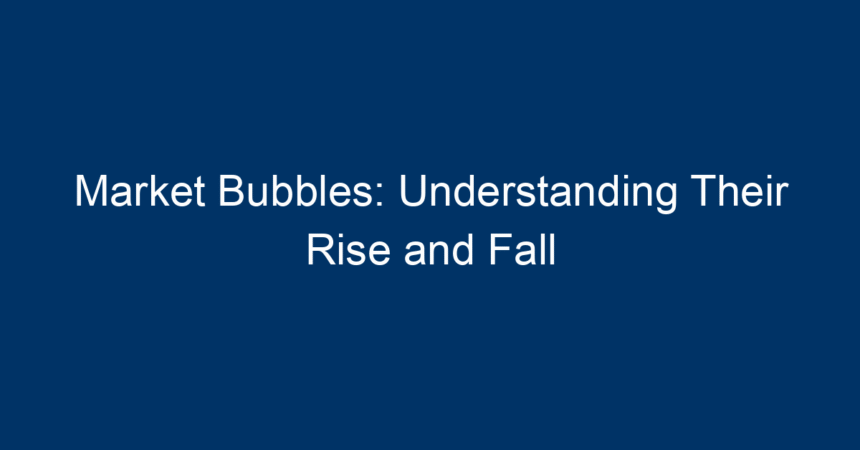Market bubbles have long captivated investors, economists, and historians alike. These phenomena occur when the prices of assets inflate beyond their intrinsic value, inevitably leading to a subsequent crash. Understanding market bubbles provides valuable insights into investor psychology and systemic risk in financial markets. In this comprehensive article, we’ll explore the anatomy of market bubbles, the factors that fuel their growth, and the consequences they bring when they burst.
What Are Market Bubbles?
A market bubble is characterized by a rapid escalation in asset prices driven by exuberant demand. Unlike a sustainable increase in value based on economic fundamentals, market bubbles thrive on speculation and irrational investor behavior. As demand surges, prices inflate to unsustainable levels, creating a disconnect between market value and intrinsic worth.
Characteristics of Market Bubbles
-
Excessive Speculation: Investors often flock to buy into a trending asset without considering its actual worth.
-
Rapid Price Increases: Prices skyrocket within a short timeframe.
-
Media Hype: Positive media coverage often amplifies the bubble, attracting even more investors.
-
euphoria: Overconfident investors believe that prices will continue to rise indefinitely.
- Subsequent Collapse: Bubbles ultimately burst, leading to significant financial losses and market corrections.
Historical Examples of Market Bubbles
Understanding the rise and fall of historical market bubbles provides context for current financial environments. Let’s explore a few notable examples.
The Tulip Mania
One of the earliest recorded market bubbles, Tulip Mania occurred in the 1630s in the Netherlands. Tulip bulbs became a status symbol, and prices soared to extraordinary levels before collapsing. At its peak, a single bulb was worth more than a house, demonstrating how speculation can drive prices far beyond their intrinsic value.
The South Sea Bubble
In the early 1700s, the South Sea Company offered shares that promised spectacular returns from its trade in the South Seas. As more investors bought in, prices ballooned. However, when reality set in, shares plummeted, leading to a devastating financial crisis in Britain.
The Dot-com Bubble
The late 1990s saw a surge in technology stocks, fueled by the internet revolution. Investors enthusiastically purchased shares in tech startups, driving valuations to unsustainable heights. The bubble burst in 2000, leading to substantial losses and affecting countless investors.
The 2008 Financial Crisis
The housing bubble prior to the 2008 financial crisis serves as a reminder of how bubbles can arise in various asset classes. Subprime mortgage lending and risky financial products contributed to inflated housing prices, which ultimately collapsed, triggering a global financial meltdown.
Factors Contributing to Market Bubbles
Understanding what creates market bubbles can help investors navigate financial waters more safely. Here are some common factors involved:
1. Speculative Frenzy
As previously mentioned, market bubbles are often fueled by rampant speculation. When the excitement surrounding a particular asset grows, investors rush to buy in, often neglecting basic financial principles.
2. Easy Credit and Low Interest Rates
The availability of cheap credit significantly impacts market dynamics. When loans are easily accessible, investors are more likely to take risks, often leading to inflated valuations. Low interest rates during economic downturns can exacerbate this effect.
3. Psychological Biases
Human psychology plays a critical role in market bubbles. Behavioral finance highlights how emotions like greed and fear can dictate investor decisions. Confirmation bias, herding behavior, and overconfidence often lead investors to ignore warning signs of overvaluation.
4. Innovations and Hype
New technologies can create excitement among investors. The promise of future profits often leads to inflated prices. While innovation is essential for economic growth, it can also be a double-edged sword when it comes to market bubbles.
The Lifecycle of Market Bubbles
1. Accumulation Phase
In this initial stage, prices rise modestly as investors slowly become aware of the potential for profit. The growth is typically grounded in some sense of value or economic fundamentals.
2. Public Awareness Phase
As media coverage increases, interest in the asset grows. Prices begin to rise more rapidly as more investors jump on the bandwagon, fueling the bubble’s growth.
3. Euphoria Phase
At the peak of the bubble, irrational exuberance takes hold. Investors are convinced that prices will continue to soar indefinitely, leading to exaggerated price levels. The absence of fundamental analysis becomes glaringly evident.
4. The Collapse
Eventually, market sentiment shifts. Reasons for concern, such as changes in economic indicators or skepticism from influential investors, emerge. As confidence wanes, prices begin to plummet, resulting in panic selling.
5. Aftermath
The consequences of a market bubble bursting can be severe. Investors may face significant financial losses, and broader economic impacts can lead to recessions or prolonged downturns.
Navigating Market Bubbles: Actionable Insights
While it is nearly impossible to predict the precise timing of a market bubble’s rise and fall, there are strategies investors can adopt to minimize risks.
1. Conduct Thorough Research
Investors should always strive to understand the fundamentals of any market before investing. Evaluating metrics, market trends, and valuations can help decipher whether an asset is overvalued.
2. Diversify Investments
Building a diversified portfolio can mitigate risks associated with market bubbles. Spreading investments across different asset classes helps shield against significant losses when a specific market experiences a downturn.
3. Stay Rational
Maintaining a rational mindset is crucial in avoiding the emotional pitfalls of investing. Refocusing on long-term goals and avoiding herd mentality can help investors stay grounded.
4. Monitor Economic Indicators
Keeping an eye on significant economic indicators—such as interest rates, inflation, and employment rates—can provide context on market conditions. Understanding how these factors influence asset prices can be valuable.
5. Be Prepared for Downturns
Developing an exit strategy before investing can be invaluable. Setting stop-loss orders or regularly reassessing the market conditions can provide a safety net during turbulent times.
Conclusion
Market bubbles are fascinating yet perilous facets of financial markets. By understanding their rise and fall, investors can navigate the complexities of market dynamics more effectively. Recognizing the signs of a bubble, leveraging thorough research, and maintaining rational decision-making can help mitigate risks associated with market bubbles. Remember, while the allure of rapid wealth can be enticing, a cautious and informed approach is key to sustained investment success. Stay informed, stay disciplined, and always be prepared for the unexpected in the ever-evolving landscape of finance.




